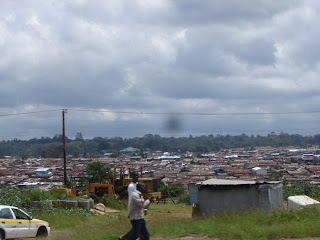


My boss and I unexpectedly had free time Tuesday morning, and decided to do a bit of sight-seeing around Nairobi. For such a large city, from which tourists head out in all directions for various safaris, I found that it has surprisingly few things to see and do. However, two of the things highly recommended (besides the Nairobi National park safari I did the day before) is the baby elephant orphanage and the giraffe sanctuary.



We first went to the baby elephant orphanage, which is formally called the David Sheldrick Wildlife Trust. A British woman, the widow of David, began rearing orphaned elephants and other animals and spent 28 years perfecting a suitable milk formula and caretaking strategy to successfully rear baby elephants, which until the age of three are milk-dependant. Every day from 11am-12pm visitors are allowed to come and watch the babies get fed out of bottles while their caretakers talk about each of them and how they became orphans. There are currently 21 orphans under the age of 2 years at the orphanage. Once they reach the age of three, the caretakers begin the long process of introducing them to wild herds of elephants in other parks, with the hope that eventually (sometimes after a year or two) the herd will accept the young elephant into their family.


Us visitors gathered around a loosely fenced pen, and watched the keepers lead a long line of adorable baby elephants down from the forest where they were practicing foraging to the feeding pen. It was amazing how fast the babies could down the giant 2 litre bottles of milk. And it was amazing to see how close they were to their keepers- one female baby kept wrapping her trunk around her keepers arm and waist as he gave his (clearly rehearsed and memorized) monologue on information about the baby elephants. We supposedly got lucky with a “small” group of visitors since it was a working day. The babies were very pushy- pushing into each other and the keepers and clearly craving contact. We were able to touch them as they came up along the fences, and practiced drinking water from large wooden buckets. It was truly one of the most adorable things I’d seen, and I learned a lot from the keepers. For instance, about half of the orphans’ mothers were victims of poaching, but the other half had almost all fallen down various wells dug by humans in their first few days of life and were thus rescued.



From there we went to the Giraffe Centre, created by a Kenyan conservation organization to educate Kenyan children and other visitors about Kenya’s wildlife and environment. Here, visitors get to feed the endangered Rothschild giraffes cereal pellets and learn all about giraffes in a cute little wooden auditorium. Watching baby elephants and feeding giraffes was certainly a great way to spend the morning.






